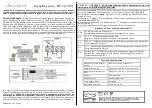
Page 16 of 87
Picture 7 Connection of the two wires from Spray box cable
The sensor is mounted on the back side of the sump of the tank.
Settings in the HC5500
“Extended Menu 5 Optional sensors" is the setup menu. In Menu E5.3.1 chose “HARDI”.
To check the connections, the frequency with an empty tank can be checked.
Menu 4.5.3.3, Tank Gauge, should read be between 100 and 200 Hz.
How does it work?
The TankGauge sensor measures the pressure created by the water in the tank. The
sensor sets data points for each 25 mm of water level. 100 data points are available. The
data points are registration marks where the tank sensor registers the pressure and
therefore how much water there is left in the tank at this water level.
The data points can be seen in Menu E8.2.3. They can also be edited in this Menu.
For setting the data points, the flow sensor must first be calibrated.
Next step is to fill the tank completely with a known quantity of water.
When the calibration starts, the flow sensor will register how much water is sprayed out and
the tank sensor will register the pressure for every 25 mm water level until the tank is empty.
At the end of the calibration, the actual verses the theoretical quantity of water is set just like
doing a “Tank Method” calibration of the nozzles. This will fine tune the flow sensor PPU.
The calibration of the TankGauge is described in the instruction book.
When the TankGauge is used in use, there are two modes:
•
When the sprayer is moving
•
When the sprayer is stationary
When the sprayer is moving, the HC5500 will calculate an average value of the read out
from the TankGauge. The average value is necessary because of the movement of the
liquid in the tank will when the sprayer is moving. If a not averaged value was shown, the
readout would be useless for the driver.
When stationary, the value is not averaged. The movement of the liquid in the tank should
stop and the average value is therefore not necessary.
Left side = Green/Gray
Right side = Pink/Yellow
















































